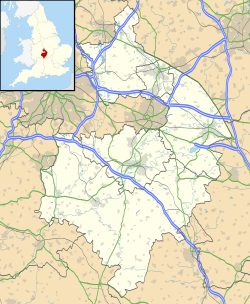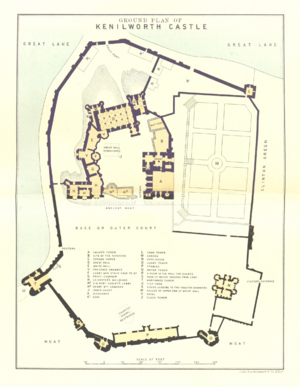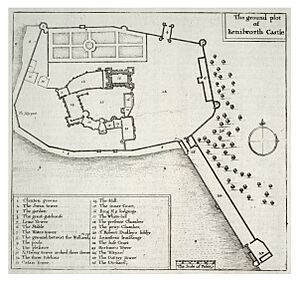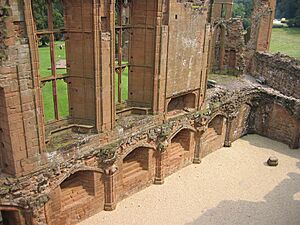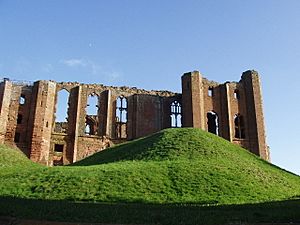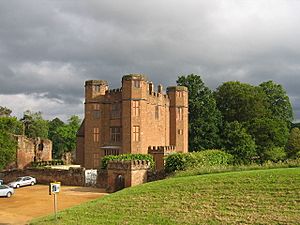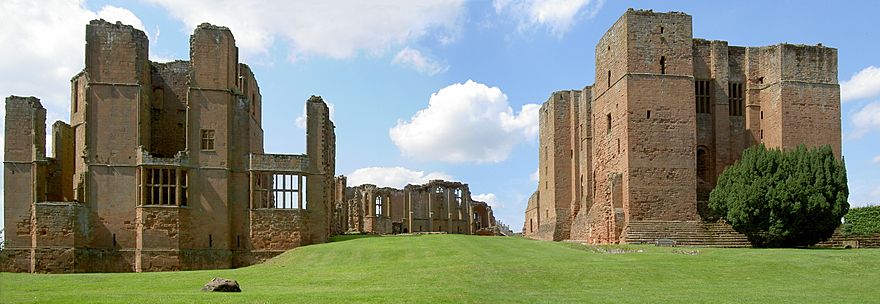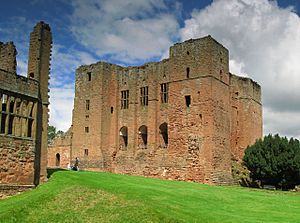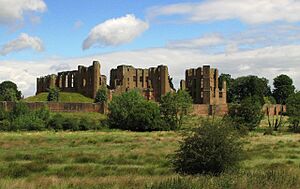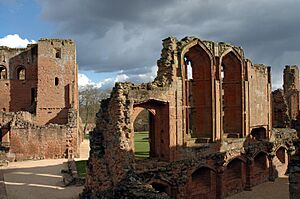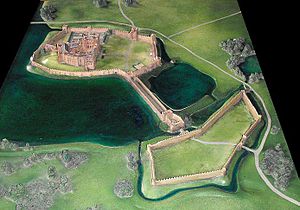Kenilworth Castle facts for kids
Quick facts for kids Kenilworth Castle |
|
|---|---|
| Warwickshire, England | |
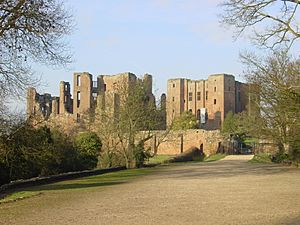
Kenilworth Castle, viewed from the site entrance
|
|
| Coordinates | 52°20′53″N 1°35′32″W / 52.3479693°N 1.5923611°W |
| Grid reference | grid reference SP2794172163 |
| Type | Inner and outer bailey walls with great tower |
| Site information | |
| Owner | Town of Kenilworth |
| Controlled by | English Heritage |
| Open to the public |
Yes |
| Condition | Ruined |
| Site history | |
| Materials | New red sandstone |
| Battles/wars | Siege of Kenilworth (great siege of 1266) |
Kenilworth Castle is a famous castle located in the town of Kenilworth in Warwickshire, England. Today, much of it is in ruins, but it is looked after by English Heritage. The castle was first built after the Norman Conquest in 1066 and was developed over many centuries, right up to the Tudor period. Experts have called it "the finest surviving example of a semi-royal palace of the later Middle Ages". This means it was a very grand and important home, almost like a royal palace.
Kenilworth Castle played a big part in English history. It was the site of the siege of Kenilworth in 1266, which lasted for six months. This is thought to be the longest siege in medieval English history! The castle was also a key base for the House of Lancaster during the Wars of the Roses. Important events happened here, like the removal of Edward II from the English throne. It was also where Henry V supposedly received a gift of tennis balls from the French in 1414. This story is said to have made him angry and led to the famous Battle of Agincourt. Later, in 1575, the Earl of Leicester hosted a huge party for Elizabeth I at the castle. Kenilworth is also known as a "water-castle" because it was protected by large lakes.
The castle was built and changed over hundreds of years. It started in the 1120s with a strong Norman great tower. King John made it much bigger in the early 1200s. He created huge water defences by building dams across local streams. These defences were so strong they could stop attacks from both land and water in 1266. Later, John of Gaunt spent a lot of money in the late 1300s. He turned the medieval castle into a grand palace fortress. In the 1500s, the Earl of Leicester added new Tudor buildings. He made the castle a very fashionable Renaissance palace.
Castle Design and Surroundings
Kenilworth Castle is mostly in ruins today. This happened because it was partly destroyed in 1649 by Parliament's forces. They did this to stop it from being used as a military base after the English Civil War. Even so, Kenilworth shows us five centuries of English building styles. The castle is built almost entirely from local New Red Sandstone.
Main Entrance and Outer Walls
To the south-east of the castle are the Brays. This name comes from a French word meaning an outer defence. Today, only earth mounds and small pieces of stone remain. This area was once a large 13th-century barbican, which was a strong outer gatehouse. It guarded the main path to the castle. This area is now part of the castle car park.
Beyond the Brays, you can see the ruins of the Gallery Tower. This was another gatehouse, changed in the 1400s. The Gallery Tower once protected a long, narrow path called the Tiltyard. This path is still there and runs for about 152 meters (500 feet) to the main castle. The Tiltyard was used for jousting in medieval times. It also acted as a dam and part of the castle's defences. To the east of the Tiltyard was a marshy area called the Lower Pool. To the west was the Great Mere. The Great Mere was a huge lake, covering about 100 acres (40 hectares). It was held back by the Tiltyard path. Today, the Great Mere has been drained and is a field.
You usually enter the outer bailey of Kenilworth Castle through Mortimer's Tower. This is a small ruin now, but it was once a strong Norman stone gatehouse. It was made bigger in the late 1200s and 1500s. The outer bailey wall is long and not very tall. King John built most of it. It has many supports but only a few towers. This is because it was mainly protected by the water system of the Great Mere and Lower Pool. The north side of this wall was almost completely destroyed in 1649.
Moving around the outer bailey from Mortimer's Tower, you would find:
- A west-facing watergate, which led to the Great Mere.
- The King's Gate, added in the late 1600s for farm workers.
- The Swan Tower, built in the late 1200s and named after the swans on the Great Mere.
- Lunn's Tower, from the early 1200s.
- The Water Tower, from the 1300s, which overlooked the Lower Pool.
Inner Castle Area
Kenilworth's inner court has many buildings built against a bailey wall. This wall was originally Norman. The inner court uses the natural defence of a small hill that rises steeply. The 12th-century great tower stands on this hill. It forms the north-east corner of the inner court. The great tower was ruined in 1649. It is known for its huge corner towers, which are like very big Norman supports. Its walls are 5 meters (16 feet) thick, and the towers are 30 meters (98 feet) high. The tall Tudor windows at the top of the tower were added in the 1570s.
Much of the northern part of the inner court was built by John of Gaunt. He was a son of King Edward III. He built between 1372 and 1380. This part of the castle is seen as "the finest surviving example of a semi-royal palace of the later middle ages." Gaunt's style focused on rectangular shapes. He separated the ground floor service areas from the upper floors. He also made the outside plain but the inside very grand, especially on the first floor. This style is an early example of the "perpendicular style."
Gaunt's most important building is his great hall. This hall replaced older halls on the same spot. It was inspired by King Edward III's design at Windsor Castle. The hall had a series of grand rooms, reached by a very impressive staircase (now gone). From the great hall, visitors could look out through huge windows at the Great Mere or the inner court. The area below the hall, used by staff, had narrow windows. The roof was built in 1376. It was the widest hall in England at the time that did not need pillars.
The great hall was designed to look balanced from the outside. The Strong and Saintlowe Towers look like matching "wings" to the hall. The base of the hall was made to look like the base of the great tower opposite it. An unusual multi-sided tower, the Oriel, was built for private gatherings. Gaunt's Strong Tower is called that because all its floors are made of stone arches, which was a very strong design.
Other parts of the castle built by Gaunt include the southern state apartments, Gaunt's Tower, and the main kitchen. These buildings shared the same style as the great hall. This made Gaunt's palace look unified, unlike older castles. Gaunt's new kitchen was twice the size of kitchens in similar castles. It measured 19 by 8 meters (62 by 26 feet).
The rest of the inner court was built by Robert Dudley, the Earl of Leicester, in the 1570s. He built a tower, now called Leicester's building, on the south side of the court. This was a guest wing that extended beyond the inner bailey wall for more space. Leicester's building was four floors high. It was built in a fashionable Tudor style with "thin walls and grids of windows." It was made tall to look good next to the old great tower. This building influenced later Elizabethan country house designs. Modern viewing platforms, added in 2014, let you see views from where Elizabeth I's bedroom used to be.
Leicester also built a loggia, which is an open gallery, next to the great keep. This led to the new formal gardens. The loggia was designed to frame the view of the gardens. This was a new design in the 1500s, recently brought from Italy.
Other Castle Areas
The rest of Kenilworth Castle's inside is split into three areas: the base court, the left-hand court, and the right-hand court. The base court is between Mortimer's Tower and Leicester's gatehouse. The left-hand court stretches around the outside of the inner court to the south-west. The right-hand court is to the north-west of the inner court. The line of trees in the base court today was added in the mid-1800s. Originally, this court was more open. It had a chapel that once stood in front of the stables. Only the chapel's foundations remain today. Each court was used for different things. The base court was for public use, while the left and right courts were for more private events.
Leicester's gatehouse was built on the north side of the base court. It replaced an older gatehouse. It was a stylish entrance from the direction of Coventry. The outside design, with its towers and battlements, looked like castles from a century before. It was similar to Kirby Muxloe Castle and the Beauchamp gatehouse at Warwick Castle. But the inside, with its wood panelling, was in a very modern Elizabethan style. Leicester's gatehouse is one of the few parts of the castle that is still complete. The stables, built by John Dudley in the 1550s, also survive. They are along the east side of the base court. The stable block is a large stone building. Its first floor has decorative timber framing. Both buildings could be seen from Leicester's building. Leicester might have wanted to create an old-fashioned view across the base court. This would remind visitors of chivalry and romance, alongside the castle's modern parts.
Gardens and Landscape
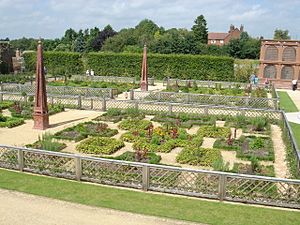
Much of the right-hand court of Kenilworth Castle is taken up by the castle garden. For most of Kenilworth's history, the garden was for entertainment. This was different from the surrounding hunting grounds. From the 1500s onwards, there were fancy knot gardens in the base court. Today, the gardens are designed to look as much as possible like they did in 1575. They have a steep terrace along the south side and steps leading down to eight square knot gardens. In Elizabethan gardens, the plants were not the main focus. Instead, the design focused on sculptures. These included four wooden obelisks painted to look like stone. There was also a marble fountain with a statue of two Greek mythological figures. A timber aviary held many birds. The original garden was greatly influenced by the Italian Renaissance garden at Villa d'Este.
To the north-west of the castle are earth mounds. These mark the spot of the "Pleasance," created in 1414 by Henry V. The Pleasance was a banqueting house. It was built like a tiny castle. It was surrounded by two diamond-shaped moats and had its own dock. The Pleasance was on the far side of the Great Mere. You had to reach it by boat. It was later taken apart by Henry VIII. Some parts were moved into the castle itself. These parts were finally destroyed in the 1650s.
Castle History
Early Beginnings (1100s)
Kenilworth Castle was started in the early 1120s by Geoffrey de Clinton. He was an important official for Henry I. We are not sure what the castle looked like at first. It might have been an earthen mound with wooden buildings. However, the stone great tower might have been part of the original plan. Clinton was a rival to the Earl of Warwick, who owned Warwick Castle. The king made Clinton the sheriff in Warwickshire to balance the Earl's power.
After Clinton died in 1133, his son, also named Geoffrey, inherited the castle. The country faced difficult times during a period called the Anarchy (1135–54). This delayed any more building at Kenilworth.
Henry II became king after the Anarchy. In 1173–74, he faced a big rebellion led by his own son. Kenilworth was used by Henry II's soldiers. Geoffrey II de Clinton died around this time, and the king took full control of the castle. This shows how important it was for military defence. By this time, Kenilworth Castle had the great keep, the inner bailey wall, a basic path across a small lake, and a hunting ground.
King John and the Great Siege (1200s)
Richard I, Henry's successor, did not pay much attention to Kenilworth. But under King John, a lot of building started again. John spent £1,115 on Kenilworth Castle between 1210 and 1216. He built the outer bailey wall in stone. He also improved other defences, like Mortimer's and Lunn's Towers. He made the castle's water defences much better by damming two local streams. This created the Great Mere. Kenilworth became one of the largest English castles of its time. It had one of the biggest artificial lake defences in England.
In 1244, Henry III gave Kenilworth to Simon de Montfort. Montfort later led a rebellion against the king, called the Second Barons' War (1263–67). He used Kenilworth as his main base. After a battle in 1264, the king's son, Prince Edward, was held hostage at Kenilworth. Edward was released in 1265. He then defeated Montfort. The remaining rebels gathered at Kenilworth Castle the next spring. Edward's forces then began to attack the castle.
The siege of Kenilworth Castle in 1266 was "probably the longest in English history." It was also the largest siege in England at the time, with many soldiers involved. The castle was protected by its huge water defences. It held out against the attack. Edward used large siege towers and even tried a night attack with boats. But the distance between the royal catapults and the walls made them less effective. Finally, a peace agreement called the Dictum of Kenilworth was made. The rebels could buy back their lands if they gave up the castle. The siege ended on December 14, 1266. The water defences at Kenilworth later influenced the building of castles in Wales, like Caerphilly Castle.
In 1267, Henry gave Kenilworth to his son, Edmund Crouchback. Edmund held many tournaments at Kenilworth. In 1279, a huge event called "the Round Table" took place. A hundred knights competed for three days in the tiltyard. This was like the popular stories of King Arthur.
Grand Palace (1300s)
Edmund Crouchback passed the castle to his son, Thomas, Earl of Lancaster, in 1298. Lancaster became the richest nobleman in England. Kenilworth became his main castle. He built the first great hall at the castle from 1314 to 1317. He also built the Water Tower and made the hunting grounds bigger. Lancaster was often against Edward II. War broke out in 1322. Lancaster was captured and executed. His lands, including Kenilworth, were taken by the king.
In 1326, Edward II was removed from power. He was imprisoned at Kenilworth in late 1326. Kenilworth was chosen because it was a strong fortress. It also had a history linked to ideas of freedom. Edward formally resigned as king in the great hall of the castle on January 21, 1327. However, it became clear that Kenilworth was not a good place to keep him. There were many people nearby who still supported Edward. So, he was moved to another castle.
Henry of Grosmont inherited the castle in 1345. He made the great hall even grander. His daughter, Blanche of Lancaster, inherited the castle next. Blanche married John of Gaunt, the third son of Edward III. Together, they became the second richest people in England after the king. John of Gaunt began building at Kenilworth between 1373 and 1380. He built a grander great hall, the Strong Tower, Saintlowe Tower, state apartments, and a new kitchen. He spent a lot of time at Kenilworth. In his later years, he made many repairs to the castle.
Royal Castle (1400s)
Many castles were left to fall apart in the 1400s. But Kenilworth continued to be used as an important "palace fortress." Henry IV, John of Gaunt's son, took control of Kenilworth when he became king in 1399. He used the castle a lot. Henry V also used Kenilworth often. He preferred to stay in the Pleasance, a mock castle he built across the Great Mere.
A writer from that time said that the French made fun of Henry in 1414. They sent him a gift of tennis balls at Kenilworth. This was meant to suggest he was not a strong warrior. But the story says this gift made Henry decide to fight the Agincourt campaign. This account was used by Shakespeare in his play Henry V.
English castles did not play a big role in the Wars of the Roses (1455–85). These wars were mostly fought in large battles. But Queen Margaret used Kenilworth as a key base. King Henry VI's court often stayed at Kenilworth for safety. Kenilworth remained an important Lancastrian stronghold. When Henry VII won the war, Kenilworth again received royal attention. Henry visited often and had a tennis court built. His son, Henry VIII, decided that Kenilworth should remain a royal castle. He moved parts of the old Pleasance into the castle.
Leicester's Grand Palace (1500s)
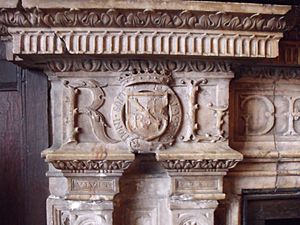
The castle stayed in royal hands until it was given to John Dudley in 1553. Dudley was an important figure under Edward VI. He started to modernise Kenilworth. He built new stables and made the tiltyard wider.
Kenilworth was given back to Dudley's son, Robert, Earl of Leicester, in 1563. This was four years after Elizabeth I became queen. Leicester continued to modernise Kenilworth. He wanted to make sure Elizabeth would be interested in visiting. Elizabeth visited in 1566 and 1568. Leicester hired people to rebuild and extend the castle. He wanted to provide modern rooms for the royal court. He also wanted to show off his noble family history. The result was called an English "Renaissance palace."
Elizabeth saw the partly finished castle in 1572. But the full effect of Leicester's work was seen during her last visit in 1575. Leicester wanted to impress Elizabeth. He hoped she would marry him. No expense was spared. Elizabeth brought 31 barons and 400 staff for the visit. It lasted an amazing 19 days! Leicester entertained the Queen with shows, fireworks, bear baiting, plays, hunting, and huge banquets. It was said to cost many thousands of pounds. The event was a big success. It was the longest stay Elizabeth made at any property during her tours. But she did not marry Leicester.
An inventory of the castle's furnishings in 1583 was 50 pages long. It included paintings and tapestries. Kenilworth Castle was valued at £10,401 in 1588. Leicester died that year without a proper heir and in a lot of debt. The castle then passed to his brother, and later to his illegitimate son, Sir Robert Dudley.
Civil War and Ruins (1600s)
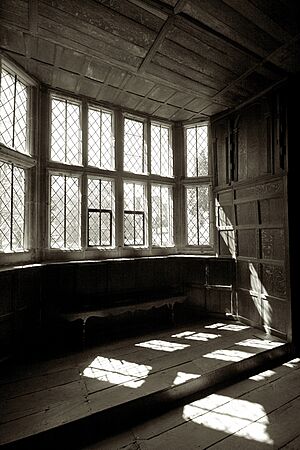
Sir Robert Dudley tried to prove he was a legitimate heir but failed. He went to Italy in 1605. In the same year, Sir Thomas Chaloner was asked to oversee repairs to the castle. This included planting gardens and improving fish-ponds. In 1611–12, Dudley arranged to sell Kenilworth Castle to Prince Henry. Henry died before buying it completely. His brother, Charles, finished the purchase. When Charles became king, he gave the castle to his wife, Henrietta Maria. Kenilworth remained a popular place for both King James I and his son Charles. So, it was well looked after.
The First English Civil War began in 1642. Kenilworth was a useful base for Charles's forces. But after a battle, the royal soldiers left. The castle was then taken by Parliament's forces. In 1649, Parliament ordered the slighting of Kenilworth. This meant partly destroying it. One wall of the great tower, parts of the outer bailey, and the battlements were destroyed.
Colonel Joseph Hawkesworth, who carried out the destruction, bought the estate for himself. He turned Leicester's gatehouse into a house. Part of the base court became a farm. Many of the remaining buildings were stripped for their materials. In 1660, Charles II became king again. Hawkesworth was quickly removed from Kenilworth. The castle was briefly given back to the Queen Mother. Then King Charles II gave it to Sir Edward Hyde. The ruined castle continued to be used as a farm. The gatehouse was the main home. The King's Gate was added to the outer bailey wall for farm workers.
Tourism and Restoration (1800s-Today)
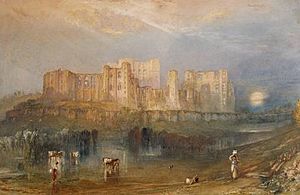
Kenilworth remained a ruin in the 1700s and 1800s. It was still used as a farm. But it also became more and more popular as a place for tourists to visit. The first guidebook to the castle was printed in 1777. Many more guidebooks followed.
The castle became even more famous after Sir Walter Scott wrote his novel Kenilworth in 1821. The book described Queen Elizabeth's royal visit. Scott's story changed some parts of the castle's history. It told the story of "the sad, beautiful, wild heroine Amy Robsart and the strong Elizabeth I." Even though it's not considered his best book, it made Kenilworth Castle very popular in the Victorian imagination. Many plays, operas, and even dioramas were made based on Kenilworth. Famous artist J. M. W. Turner painted several pictures of the castle.
More visitors came, including Queen Victoria and Charles Dickens. Work was done in the 1800s to protect the stone from falling apart. Special efforts were made to remove ivy from the castle in the 1860s.
The castle belonged to the Clarendons until 1937. Then, Lord Clarendon found it too expensive to keep up. He sold Kenilworth to a businessman named Sir John Siddeley. Siddeley gave the running of the castle to the First Commissioner of Works. In 1958, his son gave the castle itself to the town of Kenilworth. English Heritage has managed the property since 1984, and it is open to the public. The castle is a very important historic site.
Between 2005 and 2009, English Heritage tried to restore Kenilworth's garden. They wanted it to look more like it did in Elizabethan times. They used old descriptions and findings from archaeological digs. The reconstruction cost over £2 million. In 2008, there were plans to re-create and flood the original Great Mere around the castle. This would make the castle look more like it used to. It would also help with flood control in the area.
Since 2017, an exhibition called 'Speed and Power: John Siddeley, Pioneer of the Motor Age' has been on display. The Antiques Roadshow TV program was filmed at the castle in 2020.
In June 2024, during a project to make the castle easier to access, eight catapult shots were found. These were discovered in the castle grounds. They weighed between 1kg and 105kg. These shots have been dated to the 1266 siege. Experts believe they fell where they were found. This helps them guess where the siege camps might have been around the castle.
See also


